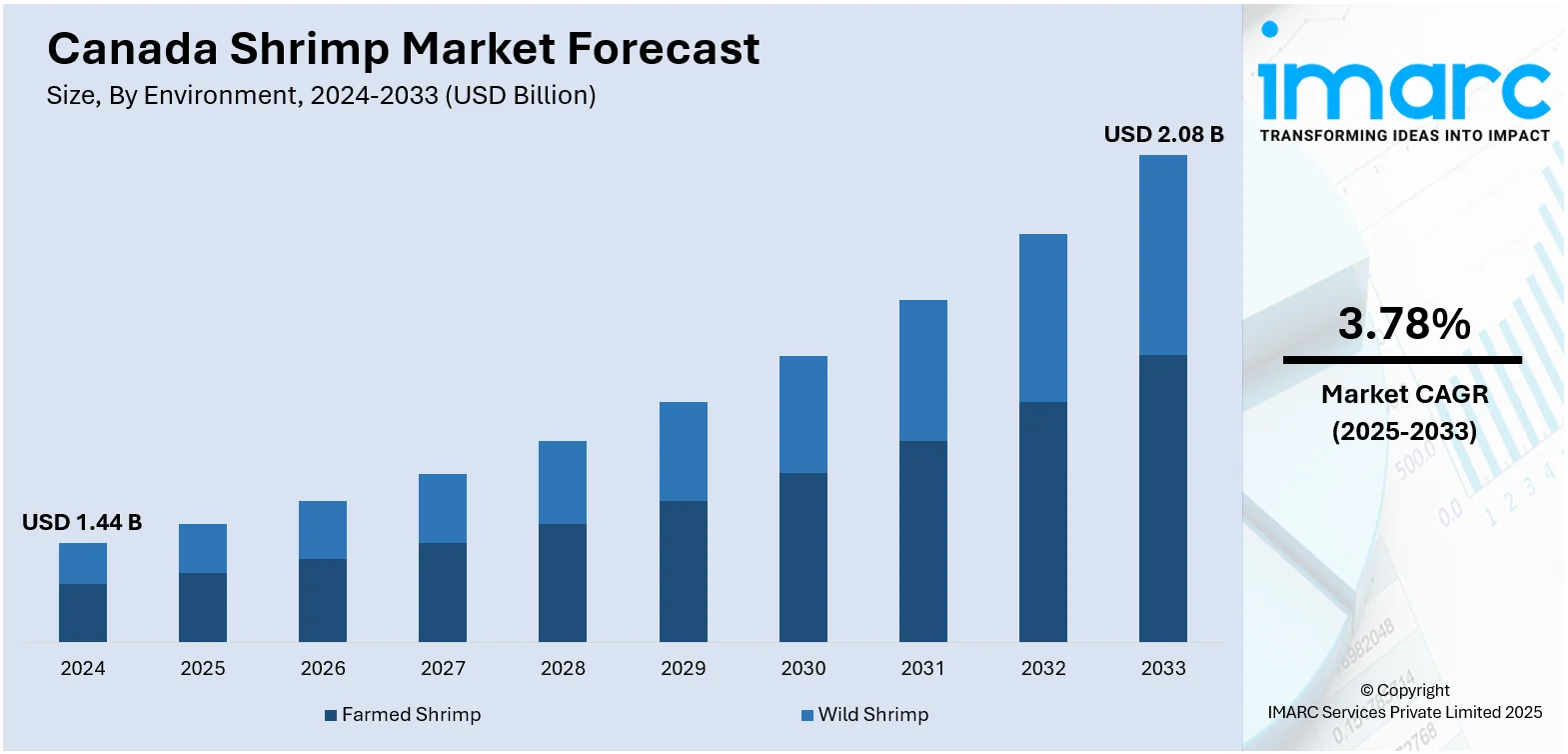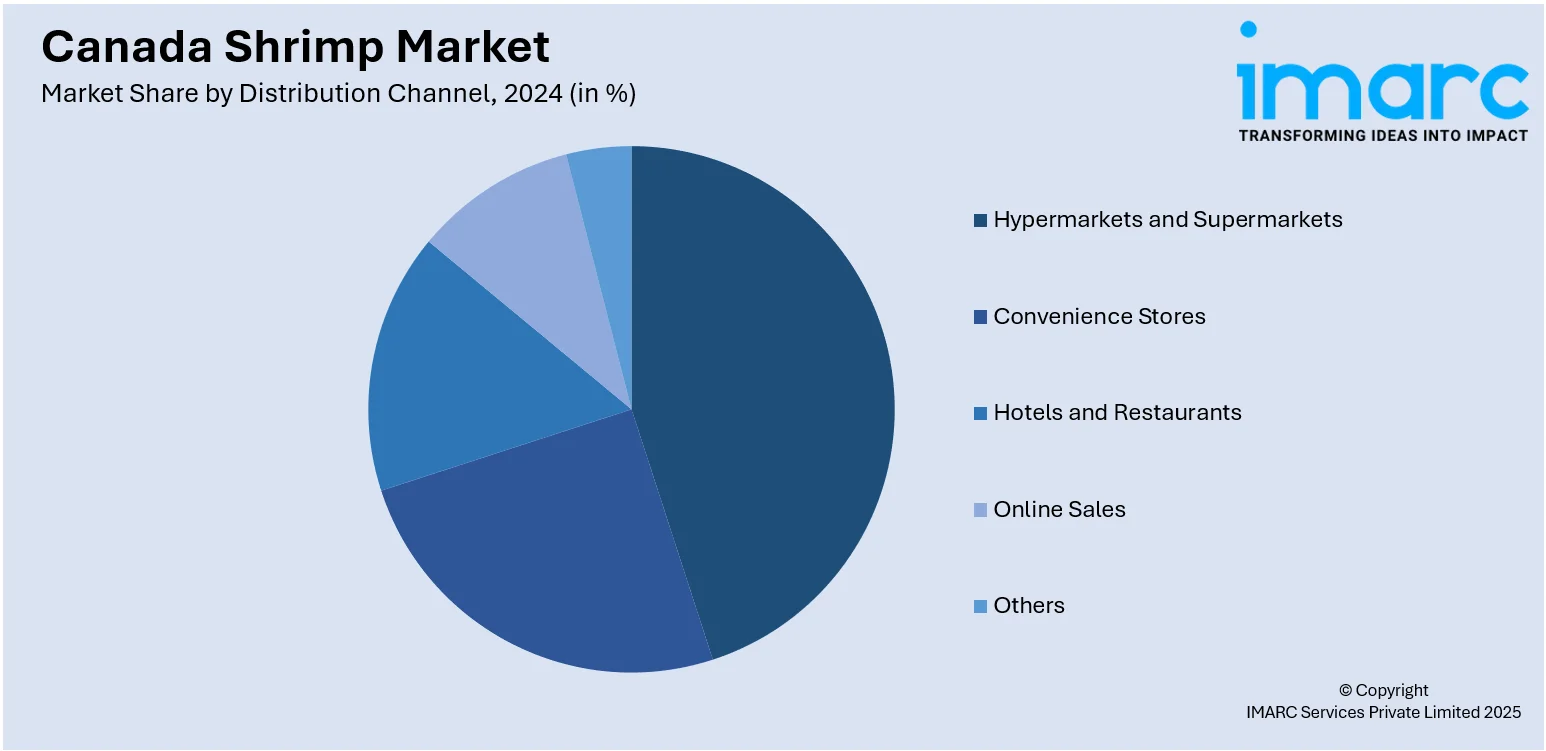
Canada Shrimp Market Size, Share, Trends and Forecast by Environment, Species, Shrimp Size, Distribution Channel, and Region, 2025-2033
Canada Shrimp Market Overview:
The Canada shrimp market size reached USD 1.44 Billion in 2024. The market is projected to reach USD 2.08 Billion by 2033, exhibiting a growth rate (CAGR) of 3.78% during 2025-2033. The market is experiencing growth due to increasing consumer demand for healthy, protein-rich seafood options. Sustainable sourcing and advanced aquaculture practices are driving trends, enhancing the Canada shrimp market share. These factors, along with expanding product offerings, continue to support market growth.
|
Report Attribute
|
Key Statistics
|
|---|---|
|
Base Year
|
2024 |
|
Forecast Years
|
2025-2033
|
|
Historical Years
|
2019-2024
|
| Market Size in 2024 | USD 1.44 Billion |
| Market Forecast in 2033 | USD 2.08 Billion |
| Market Growth Rate 2025-2033 | 3.78% |
Canada Shrimp Market Trends:
Growing Demand for Shrimp in Canada
Increased levels of awareness of the health benefits of seafood have played an important role in the expansion of the Canadian shrimp market. As people focus on protein-based diets, the demand for shrimp has accelerated because of its nutritional quality and ease of preparation. Also, there is a shift to more sustainable and responsible food sources that has supported the demand for shrimp, particularly as aquaculture technology continues to improve the environmental impact of production. Robust consumer demand for fresh, frozen, and value-added shrimp is propelling market trends. The market has reacted by diversifying its offerings, with increased emphasis on ready-to-consume and easy-to-use shrimp for time-starved households. Of particular interest is the emergence of electronic commerce websites, which has increased accessibility to shrimp even further, opening the market to a broader group of consumers in Canada. Therefore, the higher degree of availability and convenience of shrimp products are principal drivers of ongoing expansion. Additionally, Canada's strong trade agreements have facilitated international markets, further enhancing the total market share of shrimp in the region. Hence, this amalgamation of consumer demand, convenience, and strategic market placement is setting the Canada shrimp market growth in the years ahead.

To get more information on this market, Request Sample
Sustainability and Ethical Sourcing
Sustainability has emerged as a determining aspect of Canadian shrimp market expansion, where consumers and companies are increasingly turning their attention to responsible sourcing of shrimp. The push towards green practices has seen demand for shrimp increase that is sourced through certified sustainable aquaculture processes. As concerns have increased regarding overfishing and the environmental effects of shrimp farming, Canadian consumers have been looking for products bearing recognized eco-certifications, including certifications from the Marine Stewardship Council (MSC) and the Aquaculture Stewardship Council (ASC). The certifications guarantee that shrimp is produced to reduce environmental degradation, ensure ecosystem protection, and uphold fair labor practices. Recurring in response, shrimp suppliers are going green by embracing environmentally friendly packaging and joining initiatives in responsible sourcing. This shift towards sustainability is also driven by larger consumer desire for ethically produced food items as people become more aware of the source of their food. The regulatory environment in Canada is also nudging the implementation of green technologies in aquaculture to promote both environmental and economic sustainability. This increased emphasis on sustainable methods is likely to boost Canada's Shrimp market share as eco-friendly consumers increasingly favor shrimp that are certified to meet these standards.
Canada Shrimp Market Segmentation:
IMARC Group provides an analysis of the key trends in each segment of the market, along with forecasts at the country and regional level for 2025-2033. Our report has categorized the market based on environment, species, shrimp size, and distribution channel.
Environment Insights:
- Farmed Shrimp
- Wild Shrimp
The report has provided a detailed breakup and analysis of the market based on the environment. This includes farmed shrimp and wild shrimp.
Species Insights:
- Penaeus Vannamei
- Penaeus Monodon
- Macrobrachium Rosenbergii
- Others
The report has provided a detailed breakup and analysis of the market based on the species. This includes penaeus vannamei, penaeus monodon, macrobrachium rosenbergii, and others.
Shrimp Size Insights:
- <21
- 21-25
- 26-30
- 31-40
- 41-50
- 51-60
- 61-70
- >70
The report has provided a detailed breakup and analysis of the market based on the shrimp size. This includes <21, 21-25, 26-30, 31-40, 41-50, 51-60, 61-70, and >70.
Distribution Channel Insights:

- Hypermarkets and Supermarkets
- Convenience Stores
- Hotels and Restaurants
- Online Sales
- Others
A detailed breakup and analysis of the market based on the distribution channel have also been provided in the report. This includes hypermarkets and supermarkets, convenience stores, hotels and restaurants, online sales, and others.
Regional Insights:
- Ontario
- Quebec
- Alberta
- British Columbia
- Others
The report has also provided a comprehensive analysis of all the major regional markets, which include Ontario, Quebec, Alberta, British Columbia, and others.
Competitive Landscape:
The market research report has also provided a comprehensive analysis of the competitive landscape. Competitive analysis such as market structure, key player positioning, top winning strategies, competitive dashboard, and company evaluation quadrant has been covered in the report. Also, detailed profiles of all major companies have been provided.
Canada Shrimp Market Report Coverage:
| Report Features | Details |
|---|---|
| Base Year of the Analysis | 2024 |
| Historical Period | 2019-2024 |
| Forecast Period | 2025-2033 |
| Units | Billion USD |
| Scope of the Report | Exploration of Historical Trends and Market Outlook, Industry Catalysts and Challenges, Segment-Wise Historical and Future Market Assessment:
|
| Environments Covered | Farmed Shrimp, Wild Shrimp |
| Species Covered | Penaeus Vannamei, Penaeus Monodon, Macrobrachium Rosenbergii, Others |
| Shrimp Sizes Covered | <21, 21-25, 26-30, 31-40, 41-50, 51-60, 61-70, >70 |
| Distribution Channels Covered | Hypermarkets and Supermarkets, Convenience Stores, Hotels and Restaurants, Online Sales, Others |
| Regions Covered | Ontario, Quebec, Alberta, British Columbia, Others |
| Customization Scope | 10% Free Customization |
| Post-Sale Analyst Support | 10-12 Weeks |
| Delivery Format | PDF and Excel through Email (We can also provide the editable version of the report in PPT/Word format on special request) |
Key Questions Answered in This Report:
- How has the Canada shrimp market performed so far and how will it perform in the coming years?
- What is the breakup of the Canada shrimp market on the basis of environment?
- What is the breakup of the Canada shrimp market on the basis of species?
- What is the breakup of the Canada shrimp market on the basis of shrimp size?
- What is the breakup of the Canada shrimp market on the basis of distribution channel?
- What is the breakup of the Canada shrimp market on the basis of region?
- What are the various stages in the value chain of the Canada shrimp market?
- What are the key driving factors and challenges in the Canada shrimp market?
- What is the structure of the Canada shrimp market and who are the key players?
- What is the degree of competition in the Canada shrimp market?
Key Benefits for Stakeholders:
- IMARC’s industry report offers a comprehensive quantitative analysis of various market segments, historical and current market trends, market forecasts, and dynamics of the Canada shrimp market from 2019-2033.
- The research report provides the latest information on the market drivers, challenges, and opportunities in the Canada shrimp market.
- Porter's Five Forces analysis assists stakeholders in assessing the impact of new entrants, competitive rivalry, supplier power, buyer power, and the threat of substitution. It helps stakeholders to analyze the level of competition within the Canada shrimp industry and its attractiveness.
- Competitive landscape allows stakeholders to understand their competitive environment and provides an insight into the current positions of key players in the market.
Need more help?
- Speak to our experienced analysts for insights on the current market scenarios.
- Include additional segments and countries to customize the report as per your requirement.
- Gain an unparalleled competitive advantage in your domain by understanding how to utilize the report and positively impacting your operations and revenue.
- For further assistance, please connect with our analysts.
 Request Customization
Request Customization
 Speak to an Analyst
Speak to an Analyst
 Request Brochure
Request Brochure
 Inquire Before Buying
Inquire Before Buying




.webp)




.webp)












